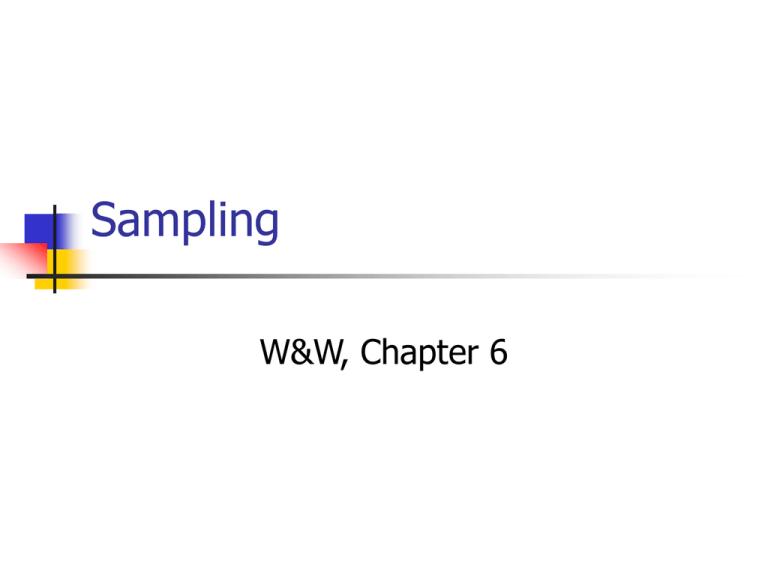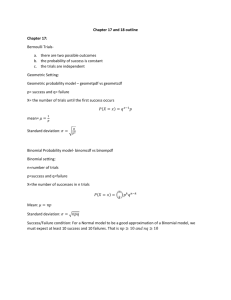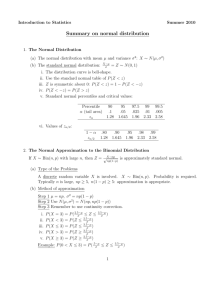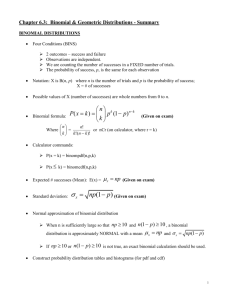Sampling
advertisement

Sampling W&W, Chapter 6 Rules for Expectation Examples Mean: E(X) = xp(x) Variance: E(X-)2 = (x- )2p(x) Covariance: E(X-x)(Y-y) = (x- x)(y- y)p(x,y) Rules for Expectation E(X + Y) = E(X) + E(Y) E(aX + bY) = aE(X) + bE(Y) E(R) where R=10+X+Y = E(10 + X + Y) = 10 + E(X) + E(Y) E[g(X,Y)] = x yg(x,y)p(x,y) Sampling What can we expect of a random sample drawn from a known population? Can we generalize findings from our random sample to the population? This is the heart of inferential statistics. Definitions Population: The total collection of objects to be studied. Each individual observation in a random sample has the population probability distribution p(x). See Table 6-1, p.190 Random Sample: A sample in which each individual has an equal chance of being selected. Definitions (continued) The sample mean is not as extreme (doesn’t vary so widely) as the individual values in the sample because it represents an average. In other words, extreme observations are diluted by more typical observations. See Figure 6-2. A sample is representative if it has the same characteristics as the population; random samples are much more likely to be representative. Sampling with or without replacement In large samples, these are practically equivalent. A very simple random sample (VSRS) is a sample whose n observations X1, X2, …Xn are independent. The distribution of each X is the population distribution p(x), that is: p(x1)=p(x2)=…=p(xn) Small Samples The exception to this rule occurs in small samples, where sampling without replacement significantly changes the probability of other X values (see page 216). Example: calculating the probability of various poker hands How Reliable is the Sample? Suppose we calculate the sample mean (M), and we want to know how close it comes to , the population mean. Imagine collecting many different samples, getting a sample mean for each sample. We could build the sampling distribution of M, denoted p(M). Example: everyone flip a coin 10 times and tell me how many heads you flipped. How Reliable is the Sample? Rather than actually sampling, we can simulate this sampling on a computer, which is called Monte Carlo sampling (or simulation). We can also derive mathematical formulas for the sampling distribution of M. Moments of the Sample Mean Recall our objective is to estimate a population mean, . If we take a random sample of observations from the population and calculate the sample mean, how good will M be as an estimator of its target, ? We start with the definition of the sample mean: M = 1/n(X1 + X2 + …Xn) Moments of the Sample Mean We start by calculating the expectation of the sample mean: E(M) = 1/n[E(X1) + E(X2) +…+ E(Xn)] Remember that each observation X has the population distribution p(x) with mean . Thus E(X1) = E(X2) = … E(M) = 1/n[ + + … + ] = 1/n[n ] = Moments of the Sample Mean We can see that E(M) = On average, the sample mean will be on target, that is, equal to . Of course, an individual sample mean is likely to be a little above or below its target (think of the coin flips we did). The key question is how much above or below? We must find the variance of M. Moments of the Sample Mean Var (M) = 1/n2[var(X1) + var(X2) + … + var(Xn)] Each observation X has the population distribution p(x) with variance 2, so: Var (M) = 1/n2[2 + 2 + … + 2] = 1/n2[n 2] = 2/n Standard deviation (M) = /n Standard error This typical deviation of M from its target, , represents the estimation error, and is commonly called the standard error. What happens as n increases? The standard error decreases, thus the larger the sample, the more accurately M estimates ! The shape of the sampling distribution Figure 6-3 shows 3 different parent population distributions. We see that as n increases, the sampling distribution has an approximately normal shape. Central Limit Theorem: In random samples of size n, M fluctuates around with a standard error of /n. Thus as n increases, the sampling distribution of M concentrates more and more around and becomes normal (bell-shaped). Normal approximation rule If we know the normal approximation rule, or Central Limit Theorem, we can look at the probability of particular values (or ranges) of M using the standard normal table. Example: Suppose a population of men on a large southern campus has a mean height of =69 inches with a standard deviation = 3.22 inches. Normal approximation rule If a random sample of n = 10 men is drawn, what is the chance that the sample mean M will be within 2 inches of the population mean? E(M) = = 69 SE = /n = 3.22/ 10 = 1.02 We want to find the probability that M is within 2 inches, or between 67 and 71. Normal approximation rule Z=M-=M- SE /n Z = 71 – 69 = 1.96 1.02 Thus a sample mean of 71 is nearly 2 standard errors about its expected value of 69. P(Z > 1.96) = .025, likewise P(Z < -1.96) = .025 Normal approximation rule Probability (67 < M < 71) = 1 – .025 - .025 = .95 We can conclude that there is a 95% chance that the sample mean will be within 2 inches of the population mean. Note that there are 2 formulas for Zscores, one for individual values of X, and one for sample means, M. Another Example Suppose a large statistics class has marks normally distributed with =72, and =9. What is the probability that an individual student drawn at random will have a mark over 80? Here we are comparing a single student’s score to the distribution of scores. Another Example Z = X – = 80 – 72 = .89 9 Pr(Z > .89) = .187 What is the probability that a random sample of 10 students will have a sample mean over 80? In this case, we are comparing the sample mean to all possible sample means, the sampling distribution. Another Example Z = M - = 80 – 72 = 2.81 /n 9/10 Pr(Z > 2.81) = .002 This sample mean is very unlikely. This shows that taking averages tends to reduce the extremes. Proportions We often express our data as proportions, such as the proportion of heads in a sample of 10 coin flips. Normal Approximation Rule for Proportions: In random samples of size n, the sample proportion P fluctuates around the population proportion with a standard error of [(1- )/n] Proportions We can see again that as n increases, our sample proportion gets closer to the population proportion. Example: A population of voters has 60% Republicans and 40% Democrats. What is the chance that a sample of 100 will produce a minority of Republicans (less than 50%)? Proportion Example Z=P-=P- SE [(1- )/n] Z= .5 - .6 = -2.00 [.6(1- .6)/100] Pr(Z < -2.00) = .023 or 2% Normal Approximation to the Binomial Of your first 10 grandchildren, what is the chance there will be more than 7 boys? This is the same as the proportion of boys is more than 7/10. We could use the binomial to solve this problem. Assume p(boy) = .5 Normal Approximation to the Binomial P(S > 7) = P(S=8) + P(S=9) + P(S=10) You could calculate this or just use the cumulative binomial table on pages 670-671. P(S > 7) = .044 + .010 + .001 = .055 We can also use what we know about proportions and that they will approximate the normal distribution to solve this problem. Normal Approximation to the Binomial We want to know the probability of getting more than 7 boys. We must calculate this as p=7/10 because we are dealing with a continuous distribution (normal), so everything between 7 and 8 must be included. Z= P- = .7 - .5 = 1.26 [(1- )/n] [.5(1-.5)/10] Pr(Z > 1.26) = .104 Normal Approximation to the Binomial Obviously, this involves some error. We can correct with the continuity correction, where we take the half way point between 7 and 8. Z= P- = .75 - .5 = 1.58 [(1- )/n] [.5(1-.5)/10] Pr(Z > 1.58) = .057 Normal Approximation to the Binomial Note that this is very close to our estimate calculated from the binomial distribution, .055! Monte Carlo Simulations A computer program that repeats sampling and constructs a sampling distribution. This approach is particularly useful for providing sampling distributions that cannot be derived easily theoretically.








